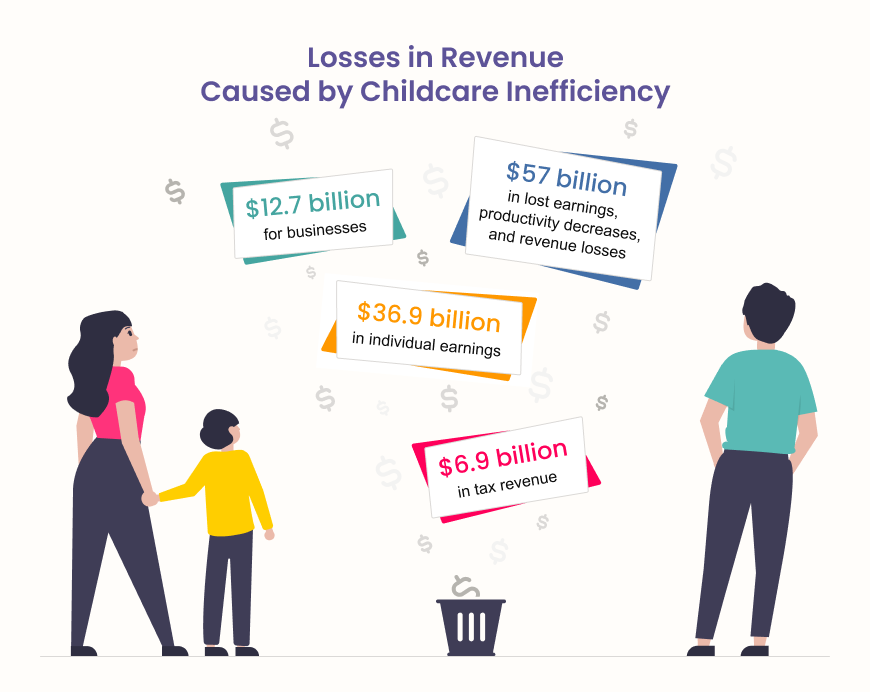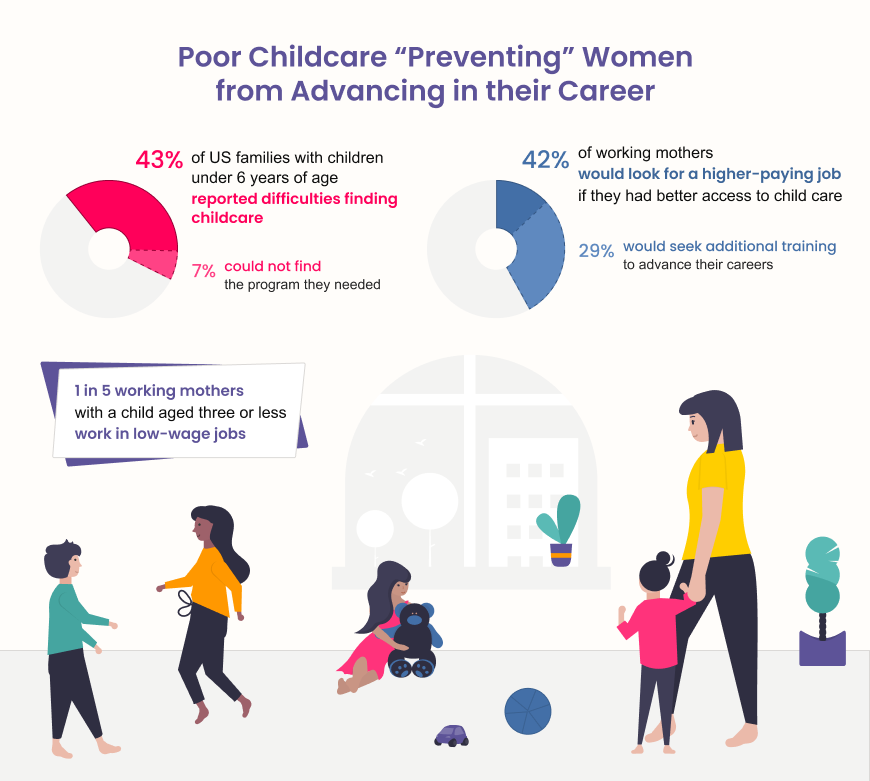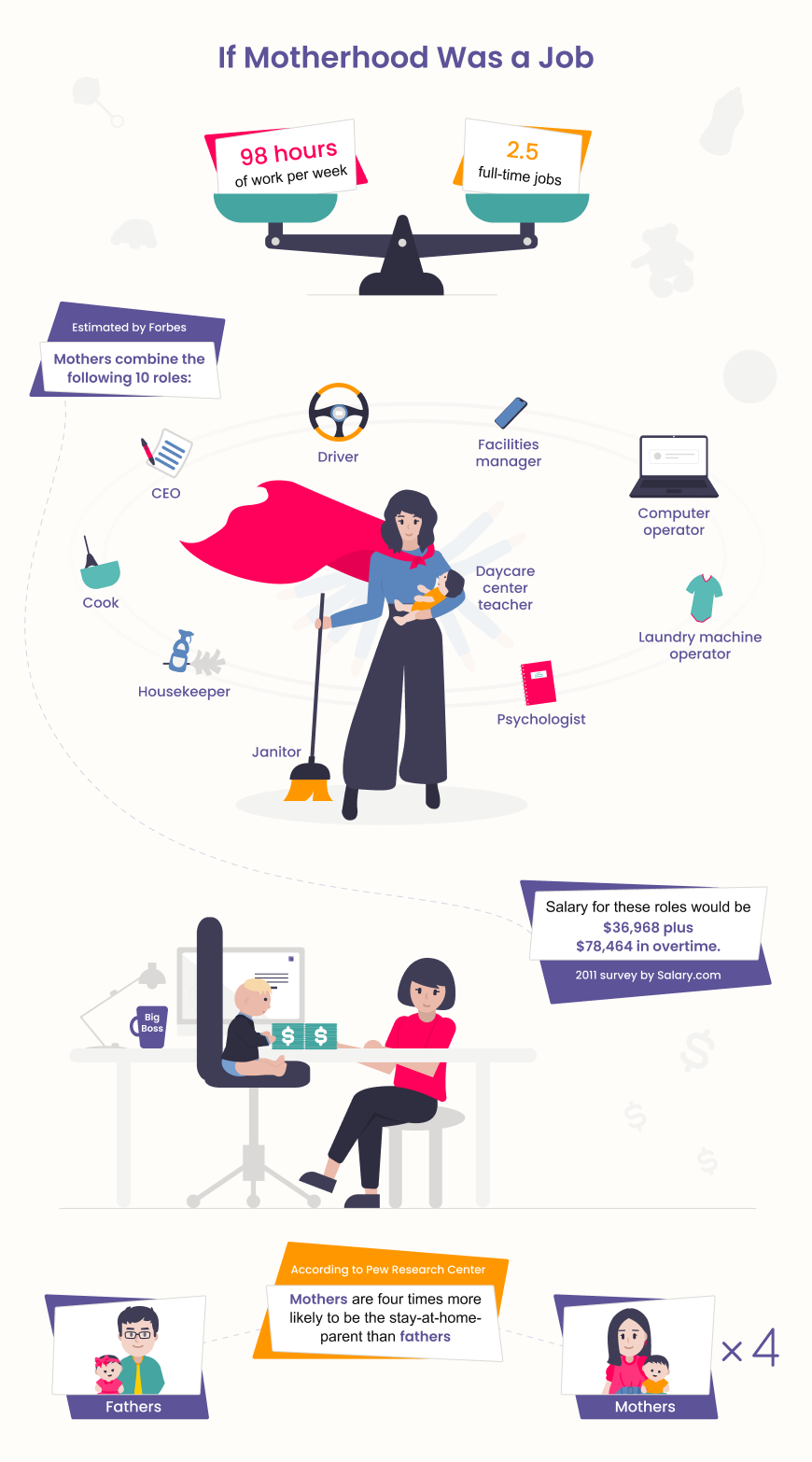
As inflation continues to sky-rocket in the post-Covid-19 world, the need to work has never been more apparent. And with many people having taken breaks from work, whether by choice or enforced, several have faced the barrier of entry associated with this leave of absence.
However, much as it’s becoming prevalent now, this barrier of entry has always been there, even in pre-Covid times. The question that needed answering, however, was who was most likely to lose out on a job position; those who lost their jobs and were unemployed or those who took time off work to care for their children?
The key findings from different studies paint a clear picture; stay-at-home parents are less likely to get hired for a job once they’re ready to get back to work. However, this is not the case compared to people currently employed. Parents who opted out of work to care for their children also fare worse than those who would have lost or quit their previous job and are unemployed.
A study by Katherine Weisshaar of the University of North Carolina revealed the extent of parents’ issues when looking to rejoin the workforce. The below graph shows that parents, regardless of gender, are up to three times less likely to get a callback for a job when compared to those already employed.

The fact that it’s also significantly lower than those currently unemployed greatly suggests potential bias against parents. Weisshaar’s study also names some factors contributing to this phenomenon.
There is a particular intensity when it comes to professional and managerial jobs that “demand intense time commitments and employers expect employees to always be available.” Working hours have increased, and technology improvements have led to an unwanted work spill into home life.
This, in turn, leads to less family time and potential conflict within the family. Parenting and work are becoming increasingly challenging to co-manage, especially given how businesses treat those who opt out of work to care for their family.
The reality is that if one parent chooses to become a stay-at-home parent, they are likely to be sacrificing their career since future applications will be looked down upon. Companies consider the decision to opt-out of work to care for the family as a lower dedication to work, using that as grounds for exclusion when applying for a job.
Expanding on her findings, Weisshaar says that the blame is being shifted to the victims rather than looking at workplace inflexibility. The above-mentioned reasons that push people to leave their jobs are directly related to an intense work culture that punishes those who prioritize family.
So, when someone leaves their job to focus more on family, the barriers to re-entry are then raised. Weisshaar’s findings suggest that companies view people who remain unemployed for a long time as having lost work sharpness, whose skills might be a bit rusty and require training. This, they feel, is probably time-consuming.
However, if that were truly the case, then callback rates for unemployed and stay-at-home parents (referred to as “opt-out” in the study) would be much closer. The discrepancy of 3.4% for dads and 4.8% for moms is evidence that parents looking to start working again are simply viewed negatively by prospective employers.
Considering gender, while the rates might appear similar, it’s worth remembering that, more often than not, women end up sacrificing their jobs and careers to take care of the family.
The “Problem” of Childcare
On paper, the solution to parents wanting to start working again was to find childcare services. However, childcare costs in the US have more than doubled over the past 20 years. Inversely, wages have not increased at a fast enough rate. Coupling this with the increased cost of living, there’s a trade-off where parents, usually mothers, sacrifice their careers to become primary caregivers.
The alternative would be an inferior level of childcare services, a choice that, ideally, no parent should have to make, as anyone would always want to provide the best for their child. So, when one reads that half of US families have reported difficulties finding decent childcare, the problem becomes ever more apparent.
Businesses rely on employees, and employees, in this day and age, depend increasingly on childcare to work more hours for better pay. The increased cost or lack of adequate childcare results in an imbalance where families have to choose between both parties having a career or one of them becoming a stay-at-home parent.
Do they spend a significant portion of their income on these services, or do they opt for cheaper alternatives of inferior quality? Do they leave their job altogether, allowing their partner to become the sole breadwinner and able to work more? This last option becomes null and void if it’s a single parent looking for childcare services.
- Single mother employment rate drops from 84% to 67% when unable to find a child care program.
- For comparison, the employment rate for mothers in 2-parent households drops from 90% to 84% when unable to find childcare.

Part of the issue is that with single mothers having to be primary caregivers and breadwinners in their household, the inability to source adequate child care means they have to find a variety of alternatives. This usually comprises a mixture of family and friends, who all have their own lives, meaning consistently finding someone to look after the child or children can be difficult.
Prospective employers look at this as an inability to commit to a work schedule, resulting in fewer opportunities for single mothers to re-enter the working world. In turn, this cuts off their source of income and ability to raise their children, creating a vicious circle of forcing people out of a job and then denying them the possibility to earn employment once again.
The alternative is to ask family members for help. Unfortunately, while it might solve the “problem” in some cases, it’s not always an ideal solution for others whose family members are still likely working themselves or are simply unable to offer the level of care that a child needs.
Number crunching time
A study in 2016 calculated that an estimated 2 million parents in the US made career sacrifices because of childcare services issues. For clarity, the challenges range from high costs, limited availability, or inconvenient hours that don’t tally with the parents’ working hours. All of this hinders economic growth on a national scale.
On the money side of things, childcare inefficiency leads to losses of:
- Approximately $12.7 billion for businesses
- Roughly $57 billion in lost earnings, productivity decreases, and revenue losses due to childcare challenges
- $6.9 billion in tax revenue
- $36.9 billion lost in individual earnings

For families, the numbers make for painful reading:
- 43% of US families with children under six years of age reported difficulties finding childcare
- 7% could not find the program they needed
- 42% of working mothers would look for a higher-paying job if they had better access to child care, while 29% of the same group would seek additional schooling/training to advance their careers
- 1 in 5 working mothers with a child aged three or less work in low-wage jobs, a workforce that is predominantly composed of women (two-thirds, to be precise)

Childcare availability and location will most likely determine where mothers can work since, more often than not, they are primary caregivers. Reducing the burden of childcare costs could boost working mothers’ prospects, allowing them to work more hours or find better-paying jobs. In either case, it would result in more income.
A National Survey of children’s health reveals more. In 2016, almost 2 million parents of kids aged five or younger had to quit, decline, or change their job due to childcare issues in their area. Therefore, companies and businesses would do well to understand why some parents have to take a break from work.
If a nationwide discussion can take place to address the issues surrounding childcare costs, quality, accessibility, and supply, then a solution for parents wanting to continue working begins to emerge. If it can be paired with a healthier work-life balance, family time does not need to be shuffled around work or shoe-horned into slots like some kind of chore.
Raising a family is meant to be a beautiful activity, not a duty to be endured or a milestone to be ticked off, and it’s time society as a whole took note.
A survey sponsored by Welch’s shows the full extent of work that mothers go through:
- Approximately 98 hours of work per week, which equals 2.5 full-time jobs
- 10 jobs for one person: Forbes estimated that mothers compile the roles of day care center teacher, CEO, psychologist, cook, housekeeper, laundry machine operator, computer operator, facilities manager, janitor and driver
- The above role would equate to a base salary of $36,968 plus $78,464 in overtime. These numbers are correct for a 2011 survey conducted by Salary.com and quoted by Forbes
- According to Pew Research Center, mothers are four times more likely to be the stay-at-home-parent than fathers, even if numbers for stay-at-home-dads are increasing

Why Stay-At-Home Moms Are Less Likely To Get A Callback
Now that we’ve crunched the numbers and can see that there’s a high degree of bias against parents looking to start working again, we’ll look at some of the reasons in more detail. In some situations, it’s a case of employer perception rather than tangible facts used as grounds for exclusion. In others, it’s as though employers are bracing for impact before even taking the plunge.
Perception of outdated skills
One of the primary reasons given against the re-employment of mothers is that some, or most, of the skills acquired during their active years would have begun to deteriorate. The idea is that it saves time and money they would spend on training.
The reality is that the employer is assuming the applicant’s skill level. And, if it were indeed the case that this is solely what’s holding back an applicant, then callback numbers of unemployed and opt-out candidates would have been far more alike than Weisshaar’s study found.
As the University Professor put it: “the reason for a lapse ought not to matter, only the lapse’s duration.” And without proper assessment, it’s difficult to quantify whether an applicant’s skills have truly diminished or can immediately reintegrate and carry on where they left off.
Expected worker norms: viewed as not committed or unreliable
From a societal aspect, the accepted norm is that work is always given priority, even beyond working hours. This becomes a problem for parents who venture outside these norms. This is even more widespread today, given how technology allows us to have an office away from the office.
Employers tend to view people negatively when prioritizing other aspects of their lives instead of work. In addition, inflexible workplace culture and long hours contribute to widespread burnout. However, someone without children taking time off work is far more likely to be able to reintegrate than a parent.
The view from employers is that those taking such time off are either not committed to their job or are unreliable workers. But, once again, this perception has more to do with a societal opinion of what the ideal worker should be like, rather than what the person in question truly feels. And in any case, commitment to family is something that should be applauded and not punished.
Therefore, it is up to us to challenge this stigma, as it currently reinforces a negative cycle of forcing parents out of working and denying them the opportunity to work their way back into it. Not only does this limit their careers, but as the numbers discussed earlier show, it’s even hurting the economy on a massive scale.
Bracing before jumping, let alone before impact
While preventing an injury is far better than treating one, it does not translate as simply when dealing with parents wanting to work again. The common view that employers take, according to Weisshaar’s study, is that applicants who have left work to become caregivers might decide to do so again in the future or could face difficulties in transitioning back to work.
The view is that opt-out-of-work-parents are somehow less deserving of work once they’re ready to start again because they’re less committed and/or reliable than the currently employed or unemployed.
Lack of childcare access
This is a glaring issue that, as described, plagues the nation as a whole and acts as an exclusion basis for all parents, especially mothers and especially single mothers. Yet, if quality childcare was reasonably priced and widespread, surveys have shown that parents would be far more capable of rejoining the workforce or working more hours.
Once again, the societal norm is for mothers to assume the role of a primary caregiver or stay-at-home parent. This results in them sacrificing their career for their children’s upbringing should not result in the form of employment punishment. However, that is the stark reality.
Solving the issue of childcare services could allow mothers, and families, to work more, earn more and provide a better upbringing for their children.
CV gap (Which Stay-at-home Moms are Ashamed of)
Taking time off work to raise a family tends to result in a CV gap that most companies will look down upon. However, the real gap is between the perception of this time away from work and the reality of what it entails.
As described, a stay-at-home parent’s duties are diverse, although they’re not simply limited to home duties. Many moms will have an active hand in family finances, home and further family planning, and potential relocations.
Despite that, many mothers feel shame about the blank space haunting their CVs. In an interview with the BBC, Heather Bolen explains that “for all the skill sets that I have, both from my corporate life, from international moves, from my own education…I felt so embarrassed for having stayed at home with my children. I was completely incredulous that I felt shame”, she says.
Professor Jennifer Bennett Shinall, a law and economics professor at Vanderbilt University, explains in the same interview that trying to hide such gaps is a common instinct. Historically, “career counselors across the board advise women who have taken a career break for childcare reasons to hide or try to disguise the fact that they had this gap on their resumés,” Professor Shinall explains.
However, research conducted by Prof Shinall and her colleague Professor Joni Hersch shows that this tends to backfire, and being honest and up-front about CV gaps works better.
However, whether open or secretive about their time away from work, almost all stay-at-home mothers struggle to return to work due to misguided perceptions. In Bolen’s case, a master’s degree and a successful corporate career at Starbucks appeared to count less than the 11 years she had spent as a full-time parent.
How Can We Help Stay-At-Home Moms?
It’s becoming increasingly evident that rather than the problem lies with the parents and their schedules, it’s a societal issue where work is prioritized over everything else. The thought process, as a whole, needs to change. Prioritizing family should not be perceived as a “crime,” and wanting to start work again should not carry any form of stigma.
However, it will take a change of heart on a global scale since the current employment structure places primary caregivers at a considerable disadvantage. Although fathers are more likely to suffer when it comes to callbacks should they interrupt their careers for childcare duties, it’s far more likely that mothers will make that sacrifice.
Additionally, it’s also more likely that mothers will be forced out of a job when workplace inflexibility and workload demand become more intense. Once that occurs, and the mother becomes the primary caregiver, there are raised barriers to re-entry.
This results in an entire workforce of millions unable to work, not for lack of effort on their part but because the standards set by the world at large are unrealistic. It’s an unsustainable model that results in massive economic losses for entire nations, businesses, and families.
However, while we wait for the inevitable revolution to take place, there’s still hope for stay-at-home mothers to start building toward their second career. There’s a large number of jobs that require no prior experience to get started.
They provide the opportunity to cease the employment gap in their CV, reducing the possibility of being treated negatively by the employer. This, in turn, gives them a better chance of finding better employment once they feel ready for the next steps in their career’s second wind.
Let’s have a look, then, at some of the jobs that can be done remotely by stay-at-home moms (and some extra on the side, for those who are itching to get out and about!).
Careers for Stay-At-Home Moms:
1. SEO Assistant

What do they do? There’s one thing every SEO assistant has at the top of their to-do list: making sure their client’s website is optimized for search engines. That sounds pretty simple, but it’s just a vague summary of the tasks you’ll have to perform.
In reality, you’ll track the performance of keywords on Google Analytics so team members can create more content based on your findings, edit, and sometimes write blog posts and articles that will enhance SEO efforts, optimize titles, meta descriptions, and alt tags, external, and internal links.
You’ll also have to keep your clients in the loop about what’s going on with their website.
How long will it take me to learn? A few months should be enough to familiarize yourself with the nitty-gritty of SEO assistance.
How do I get started? Acquire a basic understanding of SEO and what it entails. If you have experience with content management systems like WordPress or Drupal, you’ll find it easier to land your preferred role. Take online courses and remember to read books on SEO.
Not sure if you can do it all on your own? Work with an experienced SEO expert so you can receive direct feedback and guidance from someone who can help you improve.
Pay: In the United States, most SEO specialists earn an average of $22 per hour. The hourly wage of an SEO assistant varies with their responsibilities, location, and cost of living. Before setting your rate, consider whether that rate can pay your bills and if that amount justifies how much work you do.
2. PPC Assistant
What do they do? PPC means “pay per click.” With that out of the way, a PPC assistant manages keywords and ad copy, optimizes landing pages, and keeps track of the ad performance of a business.
To fill this role, you need to be familiar with tools such as Semrush, Google Ads, Google Analytics, Bing, and a ton of other advertising software.
How long will it take me to learn? Some people say that PPC courses can be completed in one day, but if you take into account how much time you’ll spend practicing what you’ve learned, you might need about a month to become a PPC pro.
How do I get started? If you’re new to the PPC world, start strong with a discounted beginner course on Udemy or this PPC Masterclass at The Knowledge Academy. Already know your way around? Browse top PPC assistant jobs on Glassdoor, Reed, ZipRecruiter, or freelance via Fiverr or Flexjobs.
Pay: This depends on the nature of your role. Freelancers usually earn between $5 and $30 per hour, while entry-level remote employees bag between $20 000 and $40 000 per annum.
3. Translator

What do they do? Translating is the process of converting information from one language into another. A translator must be able to write and speak well in the language they’re translating (source language) and the one to which they’re translating (target language). Recruiters usually prefer hiring someone with a degree in translation or linguistics or a related field.
How long will it take me to learn? To be an effective translator, you could spend up to three years learning how to speak, write, and read in the target language, source language, or both.
How do I get started? Although not absolutely necessary, certifications help you find favor in the sights of picky clients. Before going on the job hunt, try getting certified by trustworthy organizations such as the American Translators Association (ATA).
After choosing your specialty based on your expertise and interests (e.g., medical, legal, literary), join an online community where you can connect with other pro translators. Many communities exist to help translators learn new skills and find clients, like Translators Café.
Pay: You can earn between $20 and $37 per hour. Where your rate falls within this range depends on your level of proficiency in both languages, the technicality of the text to be translated, and your location.
4. Voiceover Actor
What do they do? In case you’re in the dark, a voiceover is an audio recording of a person reading a script as though acting it out on set, with all necessary emotional and tonal inflections. A pretty easy way to understand what being a voiceover artist does is to imagine being an actor without memorizing lines.
The market demand for voice actors rises every day, so there are many opportunities for anyone who is a native speaker of in-demand voiceover languages.
How long will it take me to learn? You can learn the basics of voice acting in a relatively short period of time, but it takes a lot longer to master the craft.
How do I get started? We know you have a great voice that can send even Troy Baker into hiding, but you have to learn how to use that voice. If you can’t take classes at your local community college or university, enroll in an online course on Udemy.com or Coursera.org, or learn one-on-one from a seasoned voiceover coach.
While you’re at it, procure the necessary equipment, set up and soundproof a room for recording your voiceover, and choose software for editing your voiceovers. Then, you’ll be well on your way to landing gigs on Voice123, Backstage, Upwork, or Fiverr.
Pay: Voiceover artists charge an average of $30 per hour. Feel free to fix your rate higher or lower than this bar, depending on the quality of your voiceovers and how much experience you have.
5. Online Cooking Instructor

Spending all that time at home means you have to love cooking and be good at it, or else you won’t survive. So why not teach others what you know?
What do they do? As an online cooking instructor, you can record classes on topics like baking or meal preparation and upload them to your website. Most of your website visitors might want to check out your YouTube channel and Instagram handle to see how much of your knowledge they can get for free before buying your courses, so it would certainly help if you have those handy.
How long will it take me to learn? You may need anywhere from one hour to six months to master the art of culinary education.
How do I get started? Serious about setting yourself up for success? Enroll in a Culinary Creator Business School. From insider secrets to marketing strategies, you’ll learn what it takes to attract students and gain referrals.
Ready to save a soul from another recipe malfunction? You can apply to be a chef instructor at several online culinary schools, including CocuSocial, Culinary Business School, and Teacheron. Stay one step ahead by creating projects on Upwork.
Pay: Virtual culinary instructors earn an average of $24 per hour or $38 per class.
6. Event Planner
What do they do? Have you ever dreamed of planning the perfect event? You know, the kind where everyone is having a blast, and no one feels like they should have done something else instead of attending the event? That’s what event planning is all about. You’ve got to be able to organize events, such as conferences, trade shows, and industry seminars, manage timelines and budgets, and make decisions on the fly.
In addition, you may develop marketing strategies, create promotional materials, secure event venues, hire vendors such as caterers or musicians for entertainment purposes (depending on what kind of event it is), and a host of other things that cannot fit in here.
How long will it take me to learn? It’s okay if you want to take a four-week course on event planning, but that alone won’t convince recruiters that you’re the one. You need to let employers know how passionately you’ve handled tasks related to event planning in the past and why you would do it again.
How do I get started? When you set out to become an event planner, you’ll have many hurdles to jump. Starting your own company and finding clients can feel like the biggest tasks of all. But there are plenty of other preliminary steps in between.
For example, getting certified and applying for event planning jobs on ILEAhub.com, Indeed, or LinkedIn might be the stepping stone you need toward finding an event planning gig that fits your lifestyle just right.
Pay: If you’re new to this field, expect an hourly wage of approximately $15-25.
7. Online Stylist

What do they do? As an online stylist (or personal shopper or fashion consultant), your job involves helping people find clothes that fit their body type, style preferences, and budget.
How long will it take me to learn? You can complete most online courses on virtual wardrobe styling under four weeks and six months, depending on their depth and instructor.
How do I get started? To get potential clients to trust your judgment, you should have a solid wardrobe of classic pieces and show off your best looks where they matter—online.
Second, find a niche. Whether vintage, modern, or cute, figure it out early and build your online presence around it.
Third, find a platform where you can meet potential clients or employers, like LinkedIn and Simplyhired.
Pay: The average amount online stylists bag per hour is $21. Some clients are happy to pay as low as $12. Your packages and the client’s location could also heavily influence how much you earn.
8. Bookkeeper/Tax Preparer
If you love running numbers or helping people manage their money, becoming a bookkeeper, tax preparer, or accountant might be what you need to live happily ever after.
What do they do? Being a bookkeeper involves recording financial transactions and keeping track of the accounts of businesses or individuals. Tax preparers prepare tax returns for clients so that they can file them with the IRS (or other taxing authority). Accountants keep records of business transactions and calculate profits and losses based on those transactions.
How long will it take me to learn? Within six months, you can hone necessary bookkeeping skills. Moms seeking to pursue a career in accounting can learn many of the things they need to know in two to four years. Courses on tax preparation run for an average of ten weeks.
How do I get started? Sadly, a passion for balancing income and expenses won’t be enough. To work from home as an accountant, you need a bachelor’s degree or its equivalent in accounting. Aspiring tax preparers require a Preparer Tax Identification Number (PTIN). While you need not have formal qualifications to become a bookkeeper, you must learn the basics before looking for work.
Pay: If $21+ per hour sounds like a rate that can pay your bills and heighten your love for numbers, these are the roles you’ve been waiting for.
9. Telemarketer

What do they do? The point of telemarketing is selling products or services over the phone. It’s the telemarketer’s duty to reach out to potential customers (usually businesses or individuals) to market products or services, engage with them effectively, and follow up on sales leads when needed.
How long will it take me to learn? If you put in the time and effort, you can complete certain telemarketing courses within two days.
How do I get started? Since you’ve got the basics, it’s time for some training! Take your time to learn how to make sales calls and close deals without sounding like an idiot or annoying people into hanging up on you.
Now use that skillset to showcase why you’re a good fit for jobs on Indeed, Glassdoor, and Zippia.
Pay: A good telemarketer can expect to earn $15 per hour. That amount could increase as you close more deals.
10. Dispatcher
What do they do? Dispatching is a lot like playing with your fire trucks as a kid. If you loved the thrill of sending your vehicles out on missions, then being a dispatcher might be in your wheelhouse. Dispatchers decide where vehicles and orders should go and transmit that information to drivers.
You’ll also track the movement of the company’s vehicles and log all that data with precision. And remember: because you will be taking calls from people in emergencies, they need to stay calm in tense situations and give clear instructions over the phone.
How long will it take me to learn? It depends how fast you respond to training, which can be as short as one month or as long as five years.
How do I get started? Enrolling in a dispatcher course is just the beginning of your new career. In addition to completing the course, acquire skills such as Computer Aided Dispatch, Data Entry, and Non-Emergency Calls. These skills are essential to your success and will help you stand out to recruiters when you apply for jobs.
Pay: When you’re a fresh tomato, you earn around $12 per hour. The average hourly income of intermediate dispatchers is $16, while experts earn roughly $20 per hour.
11. Online Recruiter

What do they do? If you like playing the matchmaker and helping people find their dream jobs, you might consider becoming an online recruiter. Online recruiters are not just checking boxes and scanning resumes; they’re using their knowledge of the industry to make sure that each candidate is a perfect fit for their desired role.
How long will it take me to learn? Since you’ll be the one making the final decision as to who gets hired, you should have a minimum of four to six years of experience in that industry. Completing recruiter courses and training on the job will take you between one month and two years.
How do I get started? Recruiting can be a lot like being thrown into the deep end of a pool—you either learn how to swim or sink. So how about you take these courses on Udemy?
Pay: Virtual recruiters earn between $28 and $43 per hour, depending on what industry they’re working in and how much experience they have.
12. Resume Writer
What do they do? Hiring a professional resume writer is like getting a second opinion from an expert who knows how to make you look better. Resume writers find ways to make your skills shine, look at what you’ve done in the past and use it to show why you’re perfect for the job you want now. As a bonus, they ensure that everything in your resume matches what they know about the company where you want to work.
How long will it take me to learn? As long as you have a solid command of the English language and a knack for persuasive writing, writing resumes will come naturally to you. Still, it doesn’t hurt to take a class to hone your skills, and in just a few weeks or less, you’ll be up and running with the right tools.
How do I get started? Write resumes for your friends and family, from job seekers to business owners to employees. While at it, observe your weaknesses and strengths, and show off those samples in your portfolio. Resume writers usually work independently as freelancers, so you might as well start exploring freelance marketplaces early on.
Pay: Most resume writers are paid on a per-project basis. Some can earn $50 to $300 for a single resume.
13. Online Juror

What do they do? Being an online juror is just like being a regular juror—except that you won’t be anywhere near the courtroom, and you don’t actually get to hear the case.
Instead, you listen to the evidence provided and arguments canvassed by the lawyers during a mock trial. You also read court documents, including transcripts of witness testimony, police interviews, and other information, and then give your verdict on the innocence or otherwise of the accused online.
How long will it take me to learn? Jurors are usually not required to “learn” how to be jurors. They’re regular people selected to determine the credibility of both parties to a case.
How do I get started? Register with a mock jury company. You’ll be notified via email if you’re selected to serve on a case. If you are, make sure you do your best during the trial, so the attorneys can get a good idea of what they’re dealing with.
Pay: Depending on the complexity of the case and the mock jury company, you can receive anywhere from $5 to $400 for each case.
14. Tech Support Representative
What do they do? A stay-at-home mom who works as a tech support representative will provide technical assistance to customers over the phone, email, or chat.
How do I get started? To become a Tech Support Representative, you will need to complete a few courses in tech support, computer networking, and other related topics. You need to have a basic understanding of computers, software, and other technology. Good communication and problem-solving skills are essential. You can learn all these skills from home by enrolling in an online course.
How long will it take me to learn? Learning the skills needed to become a tech support representative will take you anywhere from a few months up to a year, depending on your experience.
How much will I earn? The salary range for a tech support representative can vary depending on your experience level and the company you work for. The average tech representative can expect to earn an average of $14 – $20 per hour.
15. Virtual Call Center Agent

What do they do? A virtual call center agent has a job that involves taking calls from customers and providing customer service or technical support. You may need additional technology for this job, such as a headset.
How do I get started? To become a virtual call center agent, you must have excellent communication skills, be able to work independently, have good problem-solving skills, have good customer service skills, and have basic computer skills.
How long will it take me to learn? You can learn the skills needed in a few weeks to a few months, depending on your experience and expertise.
How much will I earn? The estimated salary range for a virtual call center is between $15 and $25 per hour. The salary range will vary depending on your experience and location.
16. Content Writing
What do they do? A content writer creates written content for websites, blogs, and other online platforms based on various topics and niches.
How do I get started? The ideal candidate will be a native speaker of the language required for the content. To get started, you will need to have excellent written communication skills, the ability to research topics, creative writing abilities, knowledge of the industry for which you are writing, an understanding of content marketing principles, and an understanding of SEO principles.
There are many platforms available to learn these skills, such as udemy.com, where you can watch online tutorials and enroll in short courses.
How long will it take me to learn? The time frame to become a content writer varies depending on the individual and the industry they are writing for. Generally, it will take you 4 weeks to 6 months to become proficient in the necessary skills.
How much will I earn? The estimated salary range for a content writer is between $30,000 and $50,000 per year. The salary range varies depending on your experience, location, and other factors.
17. Social Media Specialist

What do they do? As a social media specialist, you will be responsible for managing a company’s or person’s social media presence, creating content, and engaging with the public on a variety of social media platforms, such as Twitter, Facebook, or Instagram.
How do I get started? As a social media specialist or coordinator, you will need strong communication and writing skills. You need a good understanding of how social media works, become familiar with the various social media platforms, such as Twitter, Instagram, and Facebook, and learn how to create engaging content for each platform. A good understanding of SEO and digital analytics is vital, as are basic graphic design skills. You also need to be comfortable working with a variety of different software and hardware tools used to create and post content.
How long will it take me to learn? You should spend six months to a year studying and practicing to learn the relevant skills.
How much will I earn? As a social media specialist or coordinator, you can expect to earn an average salary of $35,000 to $65,000 annually, depending on experience and location.
18. Virtual Assistant
What do they do? Virtual assistants provide administrative, creative, or technical support to businesses, entrepreneurs, and individuals remotely.
How do I get started? You need to have excellent organizational and communication skills, the ability to work independently, follow instructions, and be able to multitask effectively. You should also have solid knowledge of social media platforms, web design, and video editing. Being familiar with and able to use certain software, like the Microsoft Office Suite, will assist you in completing tasks.
How long will it take me to learn? To learn the skills and become a virtual assistant, it may take a few weeks to a few months, depending on the complexity of the skills.
How much will I earn? Virtual assistants can expect to earn between $5 and $15 per hour, depending on their experience and the type of services they offer.
19. Tutor

What do they do? Online tutoring involves providing instruction, guidance, and educational support to students via remote online platforms such as video conferencing or online messaging.
How do I get started? You may be required to obtain a teaching certificate and/or experience teaching in a traditional classroom setting. As a tutor, you should have a solid understanding of the subject which you are tutoring, be familiar with online teaching methods, and be comfortable teaching over the internet. You need to be patient, organized, and a great communicator.
How long will it take me to learn? To obtain a teaching certificate, it may take you 1–2 years, depending on the course and institution.
If you already possess a teaching certificate or teaching experience, you may only need to spend a few weeks to a few months learning the skills necessary for online tutoring, depending on your experience and the level of expertise required.
How much will I earn? The salary range for an online tutor varies from $15 to $50 per hour. The range varies greatly and depends on the number of hours worked and the type of course taught.
20. Proofreader
What do they do? A proofreader is someone who reviews and corrects written material to ensure accuracy, clarity, and consistency.
How do I get started? You must have strong attention to detail, be able to spot errors quickly, have excellent grammar and spelling skills, and have a good command of the English language.
How long will it take me to learn? The timeframe for learning these skills will vary depending on your experience and skill level. It could take anywhere from a few weeks to a few months of reading and practicing to gain the skills necessary to become a proficient proofreader.
How much will I earn? The salary range for a proofreader can vary greatly, depending on the company and type of work. On average, proofreaders can make anywhere from $20 to $35 per hour.
21. Scopist

What do they do? As a Scopist, you will listen to audio recordings of court proceedings, depositions, and other legal documents and transcribe them into accurate and precise transcripts.
How do I get started? You need an excellent command of the English language, good typing skills, familiarity with legal terminology and court procedures, the ability to use computer programs, and the ability to work quickly and accurately.
How long will it take me to learn? The time it takes to learn the necessary skills to become a scopist is 4 to 6 months.
How much will I earn? The salary range for a scopist is between $30,000 and $45,000 annually.
22. Writing
What do they do? Starting a blog or getting writing gigs involves writing content for websites, magazines, and other publications.
How do I get started? You need to be familiar with basic web design and content creation. You must be skilled in writing, research, and communication, as well as SEO and social media optimization.
How long will it take me to learn? Depending on your current skill set, learning the skills required to start a blog and/or land writing gigs can take anywhere from a few weeks to a few months.
How much will I earn? The salary ranges from $10 to $50 per hour. The salary will largely depend on the type of project and client.
23. Instructional Videos Creator

What do they do? Film and post instructional videos are ideal jobs for stay-at-home moms looking to make extra money. This type of job involves creating instructional videos and posting them on the internet for viewers to learn from. It doesn’t take much skill because the main thing you have to do is record yourself talking about a certain topic or teaching a skill.
How do I get started? To get started, you’ll need to create an online portfolio of your work and promote it on social media platforms. This will help you get noticed by potential clients and build your online credibility.
What are the necessary skills? You’ll also need to learn how to edit videos and how to use the most recent software for making videos. Don’t be shy about letting your creative juices flow when editing. Experiment with every video editing software and study its features.
How long will it take me to learn? With a bit of practice, you can learn this job in just a month or three. Your time in practice will also depend on your availability and commitments. That means the more time you spend practicing, the faster you learn, and the shorter it takes to acquire the necessary skills.
How much can I earn? As far as salary goes, most people make an annual salary of $50,462 on average, or around $4,000 a month.
24. Local Business Representative
What do they do?Working as a local business representative is another great choice for stay-at-home moms with a special interest in business and negotiations. This job entails being an advocate and representative for local businesses in your area, helping them to advertise their products or services and grow their customer base. You’ll be responsible for speaking with business owners, networking with potential customers and clients, and promoting the business online.
How do I get started? To get started in this field, you’ll need to find local businesses that are interested in your services. You can do this by searching online or asking around your community. Once you’ve identified some businesses to work with, create a portfolio showcasing your marketing skills and be prepared to make a pitch.
What are the necessary skills? For this job to go well, you’ll need good communication and networking skills, as well as knowledge of digital marketing methods like SEO and social media marketing. It may also be helpful to have some knowledge of coding or web design.
How long will it take me to learn? How long it takes to learn the skills you need will depend on how available and committed you are. However, most people can master the basics of digital marketing in just a few weeks or months.
How much can I earn? Business representatives make an average of $67,061 annually. However, this will depend on the size of the business and how much work you’re doing. This job is also often done on a freelance basis, so you may be able to set your own rate.
25. Doing Online Surveys

What do they do? If you’re looking for a job that doesn’t require extensive skill training and that you can easily jump on, doing online surveys is a great fit for every stay-at-home mom. This type of job involves answering surveys online and providing feedback on products, services, and advertisements. It doesn’t require many skills because the main thing you have to do is answer survey questions honestly.
How do I get started? To get started in this field, you’ll need to sign up for an online survey platform, such as Swagbucks or Survey Junkie. Here, you can search for surveys that fit your interests and answer them accurately.
What are the skills needed? The skills needed to do this job are fairly straightforward: the ability to read and understand instructions; the ability to provide honest opinions and feedback; and good attention to detail.
How long will it take me to learn? It won’t take you very long to learn the basics of this job, as most surveys are straightforward and easy to complete. But it may take you a while to get used to quickly and correctly answering different kinds of surveys.
How much can I earn? The amount you can earn from doing online surveys varies, but typically you can expect to make between $0.50 and $10 per hour. This job is also done on a freelance basis, so you may be able to set your own rate depending on the type of surveys you’re completing.
26. Product Reviewer/Tester
What do they do? Product reviewers or testers are hired by companies to give feedback and reviews on their goods or services. Most of the time, they are sent samples of new products that they must test thoroughly to give honest feedback. In some cases, they may also be asked to review products that have already been released to give customers an idea of how they work.
How do I get started? To get started as a product tester, you’ll need to find companies that are looking for testers in your area. You can do this by searching online or asking around your community for leads. Once you’ve found some businesses you’d like to work with, make a portfolio that shows off your relevant experience and skills.
What are the skills needed? The skills required to be a successful product reviewer or product tester include excellent communication, an eye for detail, and the ability to express opinions accurately and honestly. You should also have good comprehension skills in order to understand instructions easily.
How long will it take me to learn? It shouldn’t take more than a few weeks for you to learn the basics of this job. With time, you can develop your skills and become increasingly efficient at testing products.
How much can I earn? Product reviewers and testers are typically paid per test, with the amount varying depending on the product being tested. Generally, it’s possible to make anywhere from $10 to $30 an hour, with an average annual salary of $38,683.
27. Transcriber

What do they do? Working as a transcriptionist or transcriber as a stay-at-home mom is a great source of additional income that doesn’t require heavy skill training. This type of job involves listening to audio recordings and typing out what was said into a text document. It requires excellent listening skills as well as the ability to accurately translate what is heard, including any background noise or interruptions.
How do I get started? To get started as a transcriptionist or transcriber, you’ll need to look for companies that offer transcription services and apply for an open position. After being hired, you might be asked to take a typing test to see how fast and accurately you can type. It won’t take very long to learn the basics of this job, but it may take some time to become more efficient at transcribing audio recordings.
What are the necessary skills? The necessary skills for a transcriptionist or transcriber include excellent listening and concentration abilities, accuracy when it comes to typing out what was said, and good attention to detail. It’s also important that you have the ability to work independently and follow instructions.
How long will it take me to learn? It shouldn’t take more than a few weeks to learn the basics of this job. With practice, you can hone your transcription skills and become increasingly efficient at transcribing audio recordings.
How much do I earn? Depending on the work they do, transcriptionists and transcribers in the US make between $13 and $29 an hour, or $46,569 a year. This job can be done on a flexible basis, so you’re able to set your own hours and work as much or as little as you’d like.
28. Online Travelling Assistant
What do they do? An online traveling assistant is an ideal job for stay-at-home moms looking to work from home. A travel assistant helps people plan their trips, book flights and hotels, and do other things related to travel. They need to have good research skills in order to find the best deals for their clients’ trips.
How do I get started? To get started as a traveling assistant, you’ll need to find companies that are looking for travel assistance and apply to them. Or you can also join groups or communities on social media and look for people who are looking for help traveling. However, this only works when the location is near where you are staying.
What are the necessary skills? Some of the skills needed are good customer service skills, the ability to solve problems, and the ability to work on your own.
How long will it take me to learn? It shouldn’t take more than a few weeks to learn the basics of this job, but with time and experience, you can become more efficient.
How much can I earn? Generally, traveling assistants make an average of $35,093 a year or $16.87 per hour, depending on the company they are working for.
29. Photographer

What do they do? If you’re taking care of your children and have the freedom to look for an additional one, look no further than becoming a photographer. As a photographer, it would be your job to take pictures at weddings, birthday parties, and other events.
How do I get started? To get started as a photographer, you’ll need to look for companies that hire photographers or search online for freelance jobs. You’ll also need to have some photography equipment, such as a camera, lenses, and lighting equipment.
What are the skills needed? A photographer needs an artistic and creative eye, technical knowledge of photography equipment and techniques, and the ability to work on their own. Also, you need to be able to follow your clients’ instructions well and have great customer service skills to make sure your clients have a good time.
How long will it take me to learn? It won’t take long to learn the basics of this job, but with time and experience, you can become more efficient at taking photos.
How much can I earn? Photographers make an average of $17.89 per hour, or $44,472 a year, depending on the type and load of work they do.
30. Virtual Receptionist
What do they do? A virtual receptionist is a great job for stay-at-home moms who want to make some extra money. As a virtual receptionist, you would be responsible for answering phone calls, taking messages, and routing calls to the correct departments.
How do I get started? To get started as a virtual receptionist, you’ll need to search for companies that offer these services and apply for an open position.
What are the skills needed? Generally, you need to have good communication skills and the ability to address different customers in a way that puts them at ease.
How long will it take me to learn? The only thing that you need to practice here is how you will be addressing different customers in a certain situation. You can learn the skills you need to become a qualified virtual receptionist in two to three weeks.
How much can I earn? Virtual receptionists make an average of $17 per hour and a monthly salary of around $3,000, depending on the company they are working for.
31. Meal Prepping/Catering

What do they do? Ready to take your skills in the kitchen to the next level? Meal prepping allows you to show off your culinary expertise and make extra cash! A meal prepper is someone who orders ingredients, prepares them according to their client’s preferences and specifications, and packages them in a way that will keep them fresh until they’re ready to be served.
But some of you have done the meal prep thing to death. You’ve been chowing down on the same meals every day, day in and day out. So what’s stopping you from catering? Catering lets you plan menus and get outside the pantry door by preparing different meals for parties.
Or maybe baking is more your thing? Bakers create bread and pastries for sale every day and sometimes take special orders for events, too! Whether you cater or bake, one way to get more clients is to include finger foods among your offerings.
How long will it take me to learn? Meal prepping is like planning for the future. So if you’re already a good cook, you can learn how to meal prep within one to four weeks.
Caterers, on average, can become competent after 6 to 12 months of training. Bakers may need 5 weeks to 3 years to master the basics.
How do I get started? If you’re planning to launch into the meal-prepping business, you’ll want to arm yourself with as much information as possible. YouTube videos, ebooks, Zoom classes, recordings, and even in-person workshops are free or low-cost resources that can help get you started.
New chefs and bakers can start by catering for people they know, sell pastries online, then move on to supplying supermarkets or restaurants. You can also partner with online catering platforms such as ZeroCater, Cater2.me, and ezCater to reach more customers.
Pay: Caterers, food preppers, and bakers make between $14 and $15 per hour.
32. Data Entry
What do they do? Working as a data entry specialist is an excellent job for stay-at-home moms looking for extra income while working from home. As a data entry specialist, you would be responsible for entering data into different computer programs, such as spreadsheets and databases. To ensure the data is correct, you’ll need to be attentive to detail and have great organizational skills.
How do I get started? To get started as a data entry specialist, you’ll need to search for companies that offer these services and apply for an open position. You’ll also need to be proficient with computers and possess excellent typing skills.
What are the skills needed? The necessary skills needed for a data entry specialist include excellent typing skills, the ability to work independently, and proficiency with computers. You’ll also need to stay organized and correctly enter data into computer programs.
How long will it take me to learn? Depending on how fast you learn, earning and practicing for two weeks to a few months
How much can I earn? Data entry specialists in the US make an average of $17 an hour, or an annual salary of $36,365.
33. Pet Sitter / Groomer

What do they do? Being either of these things takes a lot more than loving animals.
As a pet sitter, you’ll find yourself caring for other people’s dogs and cats when their owners are away. You might go to their houses, feed and walk the pets, and clean up after them. In some cases, you may even host those pets overnight or over the weekend.
You know what’s a real pain? Grooming your pet. Pet groomers, however, deal with the dirty work so our furry friends can look their best. A regular grooming session involves bathing and combing out mats, trimming nails, cleaning ears and teeth, flea treatments, and more.
How long will it take me to learn? One route to learning pet grooming is to become an apprentice and train at a pet grooming parlor for about 12 to 18 months. But if you’d rather learn in your pajamas, online courses are available. And if you don’t have a feline or canine companion to practice on, you could always groom your friends’ pets.
How do I get started? If you’re good with pets, you can find pet-sitting work in your neighborhood by spreading the word among your friends and neighbors or signing up at sites like TaskRabbit. You can start your new career as a pet groomer with an apprenticeship program or by taking virtual pet grooming classes. Only the sky’s the limit from there!
Pay: Pet sitters can make the low end of $14 per hour, while pet groomers earn around $19.
34. Flipping Items on eBay
What do they do? When you’re flipping something on eBay, you’re buying something at a low price and then reselling it for more. In other words, you’re profiting from the difference between what you pay for an item and what it sells for.
How long will it take me to learn? Most paid and free online courses on the subject are around eight hours long, so you can learn how to earn top dollar in less than a week.
How do I get started? Before you start selling on eBay, think about what kinds of things you can sell. Look for things that are easy to get and have a high profit margin.
Pay: Some eBay flippers earn as little as $0 per month, while others earn $3000 or more. How much profit you make determines where you lie on this spectrum.
35. Laundry Service

What do they do? Do you love the sweet smell of clean clothes wafting from the basement, hearing the sound of the spin cycle and gentle swooshing of the washing machine? Feel free to dance a little because providing laundry services in exchange for money might be just what you need.
How long will it take me to learn? If laundering is a part of your life, you’re ready to offer laundry services!
How do I get started? First things first: get a washing machine, a dryer, and a driver’s license because you might need to drive to collect and deliver laundry. If you have all three, find a customer base by signing up as a laundry provider with one of the many laundry companies today, like Laundry Care or TaskRabbit.
Pay: On Laundry Care, clients pay by the bag, not the hour. The average cost per bag of laundry is $20, plus an additional $3 per item ironed. Care.com and TaskRabbit run an hourly wage system, where you can average $17 per hour.
36. Childcare Service
What do they do? Daycares, babysitters, and nannies share one thing in common: they take care of your kids while you’re away from home. That’s what childcare service providers do; keeping kids entertained and helping them learn new skills.
How long will it take me to learn? The simple answer is that it depends. Some courses, such as those on Alison and Udemy, last three to four hours. Meanwhile, on-campus childhood education programs like the one offered by San Jose City College typically take two years to complete. In the end, it’s up to you to decide what works best for you.
How do I get started? If you want to take care of children, you should first acquire the required hard skills (such as CPR) and soft skills (like patience).
Pay: $18 an hour is what we’re looking at. It’s not enough to live the high life, but certainly enough to keep the lights on.
Sources
https://journals.sagepub.com/eprint/wss5qdJRASWnqYiQiBpp/full
https://www.masslive.com/news/2020/01/stay-at-home-moms-work-on-average-25-full-time-jobs.html
https://www.bbc.co.uk/news/world-us-canada-56683854
https://www.weforum.org/agenda/2018/03/stay-at-home-parents-find-it-harder-to-get-a-job/
https://www.msnbc.com/know-your-value/planning-return-work-don-t-make-1-mistake-n861341
https://finance.yahoo.com/news/moms-why-aren-t-getting-185158423.html
